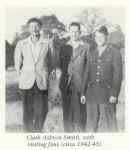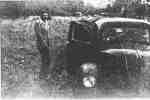The 'Weird Willys'
Francis T Laney
Excerpt from Chapter Four of Ah, Sweet Idiocy
I had a definite date to meet Bob Hoffman and go meet Clark Ashton Smith on November 1 [1943].
A druggist fixed me up with some throat tablets which gradually brought me out of it, but I was a pretty sick lad for a couple of days. Aaron [Shearer, a friend of Duane Rimel's—Ed.] did most of the driving, though, and the easy stages of the next two days had me OK by October 30, when we laid over in the sun at Chico. John Cunningham was stationed there at the time, but we didn't bother—spending several hours looking through second hand stores and getting a number of very desirable records. Around sundown we finally arrived at Camp Beale, headquarters of RAHoffman and the 13th Armored Division.
Bob had reserved a room for us in the guest barracks; we had considerable difficulty locating both it and Hoffman, but finally made the grade. The three of us chatted for a while, then Aaron heard music coming from somewhere and went to investigate. Bob and I adjourned to his barracks, where my civvies brought me the biggest barrage of whistles and catcalls I ever had in my life. I managed to weather the storm, though, and soon found myself in the middle of a big conflab with his cell-mates, all of whom went to great lengths telling me to stay out of the Army. In mid- evening, Bob recollected that he had prepared some Hoffmania for The Acolyte, so we adjourned to the chaplain's office and spent nearly an hour looking at the crifanac Bob had been doing on Army time.
It being closing time at the Post Library, we went thither to meet one of the librarians, an attractive but plump girl whose name I no longer recall, but who had been subscribing to The Acolyte with considerable interest and had been having big bull sessions of a fantastic nature with Rah. We collected her and walked through a big recreation hall where a dance was in progress. Struck by a certain familiarity in the solo guitar, I moved where I could see, and sure enough, his civvies sticking out like a sore thumb, there was my boy Aaron sitting in with a 15 piece Gl swing band and having the time of his life.
Bob, the girl, and I went to the parlor of the visitors' barracks and spent the rest of the evening talking about fantasy, arguing about music, and generally conflabbing. In the course of all this, Bob and I perfected our plans to visit Clark Ashton Smith the next day, and the session closed on a high note of excitement.
We had to wait until noon the next day for Rah to clear himself with Uncle, but the time passed very quickly when we got to watching a bunch of tanks manoeuvring. The Weird Willys [a 1938 Willys sedan—Ed. ] creaked and we moaned when Rah finally squeezed into the front seat with us, for he is what might well be described as a Plump Boy, and that tiny car was plenty full to start with—but the couple of hours drive to Auburn passed very quickly, despite a lousy road that knocked another couple of thousand miles off WW's life.
Smith lives a couple of miles out of town, and is at least a quarter of a mile from the nearest road. So we parked on the edge of a dirt cow-track, and started walking through what Hoffman insists is the fabulous Forest of Averoigne, actually the remains of an orchard abandoned to the wilderness. Smith's cabin, a weather-beaten two room shack, sits well away from the trees in the midst of a rocky and desolate pasture. On approaching it, one is struck equally by its forlorn loneliness and by the beautifully built rock wall Smith has built around his dooryard.
I had of course heard a great deal about Clark Ashton Smith, and seen many pictures of him, but none of this had prepared me adequately for the man himself. He is tall and slender but well-made, and has a much more striking and massive head than his pictures indicate. On the occasion of our visit he wore dark slacks with a light sport coat and of course his omnipresent beret; trivial, perhaps, to mention the man's clothes, but it seemed vaguely incongruous to find the man who had written the sort of thing he has, dressed like any college student. And even more incongruous was it to discover, with a touch of pleased surprise, that the man I had thought of as aged and vibrant with a knowledge not of this world was instead as youthful as any of us. Smith is extremely shy at first, but as he gradually comes to feel that he is among friends who will not ridicule his mode of life and thought, he unbends, and becomes one of the most gracious hosts and entertaining conversationalists I have ever known.
We spent the afternoon drinking wine, talking, and being shown Smith's collection. His books, a choice and varied lot, including many surpassingly beautiful illustrated editions, are very much worth examining, but the real stab came from the surprisingly large quantity of artwork, mostly the creation of Smith himself. His sculptures, using the small boulders picked up in his yard, are somewhat known to fantasy lovers, several of them having been shown on the dust jacket of Lost Worlds and in the illustrations in Marginalia. There were far more of them, however, than I had imagined—at least a hundred.
But the high point of the afternoon came when Smith brought out a stack of original drawings and paintings at least two feet thick. Perhaps 25 or 30 of them were commercially published ones, including the originals of most of Smith's drawings from Weird Tales, and the Finlay original from "The Thing on the Doorstep". (This last, incidentally, is by far the best Finlay pen-and-ink I have ever seen. Made before Virgil started drawing to size, it measures something like two by three feet, and has a mellowed beauty encountered but rarely among magazine illustrations.) There were also several early Boks, including a couple of wonderful unpublished ones, and an unpublished Roy Hunt drawing of Tsathoggua.
Smith's own drawings and paintings, every one of them unpublished, made up the rest of the stack. Nothing of his that has been published gives any inkling of the man's stature as an artist. In technique, of course, he lacks a good deal, being entirely self-taught. But he more than makes up for it with subtle and bizarre ideas, by a surprisingly good sense of form and structure, and above all by his unconventional and often superlative use of color. Most of the paintings are done in showcard paint, or something very much like it; they tend to be garish, but yet there is a certain use of restraint that makes even the most unrestrained ones quite acceptable. Perhaps twenty show entities from the Cthulhu Mythos; the remainder are extraterrestrial landscapes, divided about equally between non-human architecture and alien plant life.
Of the conversation I no longer remember much. Unforgettable, though, was
Smith's impressive recitation of a medieval formula to raise the Devil. The afternoon was just guttering away into twilight, leaving the room in a hazy half darkness; between the look in Smith's pale eyes, the overtones in his voice, and his powerful delivery, I must admit that the chills were really going to town playing hide-and- seek along my backbone. Materialist that I am, I was actually relieved when Smith paused and remarked that he wouldn't repeat the spell a third time, for fear it would work! Then he laughed and the spell broke. But the man has dramatic powers which I believe might have made him famous as an actor had he followed that art.
With the onset of darkness, we went into town for dinner, taking Smith to a Chinese restaurant he had recommended. Our entry took on the air of a triumphal procession when we encountered the Auburnites, nearly all of whom greeted Smith warmly by name. It was pleasant to see that he is so well thought of by his fellow townsmen, a type of recognition not always given to creative artists.
Smith had a date at 8:00, so we left him downtown and headed the Weird Willys toward the Golden Gate. His parting sally was unforgettable. Aaron was riding high on a fresh fruit kick, and just as we were leaving he dashed into an open market and bought a large sack of grapes. Smith looked at him with an air of profound disbelief, turned to me and whispered, "That may be all right, but personally I prefer the finished product."




